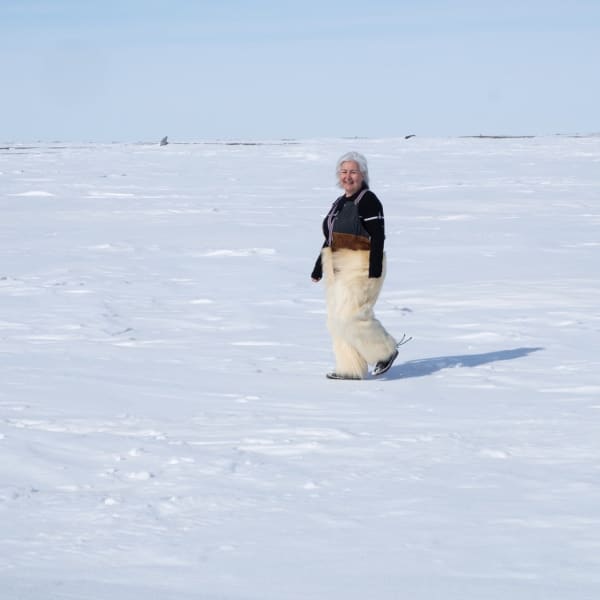Maureen Gruben: Moving with joy across the ice while my face turns brown from the sun: Fazakas Gallery, Vancouver, BC
Maureen Gruben
Moving with joy across the ice while my face turns brown from the sun
November 5 - December 21, 2019
Fazakas Gallery, Vancouver, BC
Every April, community members from Maureen Gruben's hometown of Tuktoyatuk expertly pack family sleds with everything they need to live on the land and hitch them to Skidoos. They cross miles of frozen tundra to gather at Husky Lakes where they set up their canvas tents and off grid-cabins for the spring ice fishing season. On a sunny day in early spring, the landscape at Husky Lakes is both brilliant and minimal, consisting simply of a dazzling expanse of snow under vivid sky. An absolute silence that few people will encounter in their lives is punctuated with sociable chatting as friends and relations meet each other at fishing holes, and with the occasional buzz of augurs, the periodic approach and departure of the Skidoos. Sleds have always been an integral part of Inuvialuit life. Many contemporary sleds are still hand-built; no two are identical. Idiosyncrasies of carpentry techniques and rope knotting trace a material, deeply personal relationship to their makers, and these traces become more pronounced as the sleds are mended over the years to increase their life-span.
For Moving with joy across the ice while my face turns brown from the sun, Maureen borrowed fourteen of these hand-built sleds and brought them together into a short-duration land art installation that has been photographically documented.
Each sled is intimately connected to a family that has created, used, and maintained it over years; their grouping here speaks to the collective and absolutely necessary strength of community in the Arctic.
In her associated set of assemblages, which loosely evoke the sled form, Skidoo snow flaps salvaged from the Tuktoyaktuk dump and beluga vertebrae found on the coast are bound together with rope sourced from ghost nets washed onto Tuktoyaktuk beaches, reflecting complex intersections of life and industry that circulate above and below the ice of the Western Arctic. An engagement with objects built for traversing this specific landscape has an intrinsic connection to the erosion of this land, and the melting of the ice on which people and animals have lived and hunted for thousands of years.
As such, Moving with joy across the ice while my face turns brown from the sun offers vitally important perspectives on a rapidly changing environment and way of life. The deeply social, distinctively personal elements at play here convey ways in which we, as humans, are communally and individually embedded in the land.
-
 Maureen Gruben, Moving with joy across the ice as my face turns brown from the sun (Sled), 2019 Sold
Maureen Gruben, Moving with joy across the ice as my face turns brown from the sun (Sled), 2019 Sold -

Maureen Gruben, Moving with joy across the ice as my face turns brown from the sun (Assemblages #1 - #7), 2019
NFS
-

Maureen Gruben, Moving with joy across the ice as my face turns brown from the sun (Formation 1), 2019
Sold
-

Maureen Gruben, Moving with joy across the ice as my face turns brown from the sun (Formation 2), 2019
Sold
-
 Maureen Gruben, Moving with joy across the ice while my face turns brown from the sun (Polar Bear Pants), 2019 Sold
Maureen Gruben, Moving with joy across the ice while my face turns brown from the sun (Polar Bear Pants), 2019 Sold






